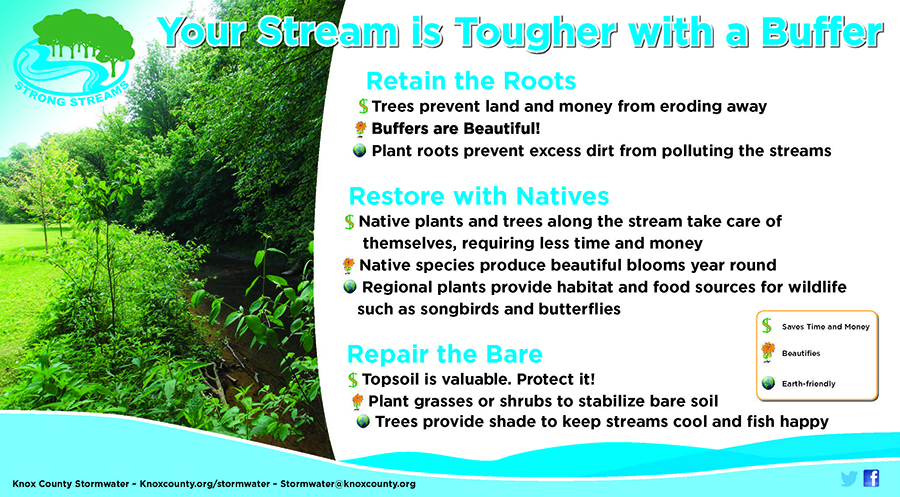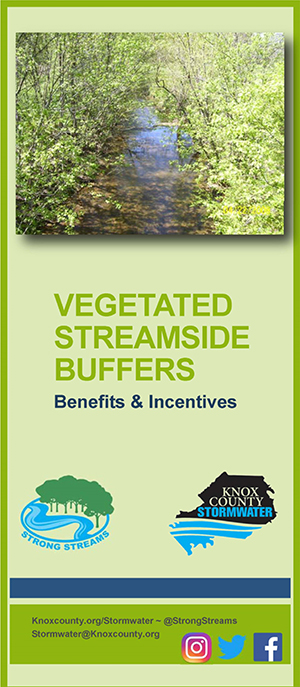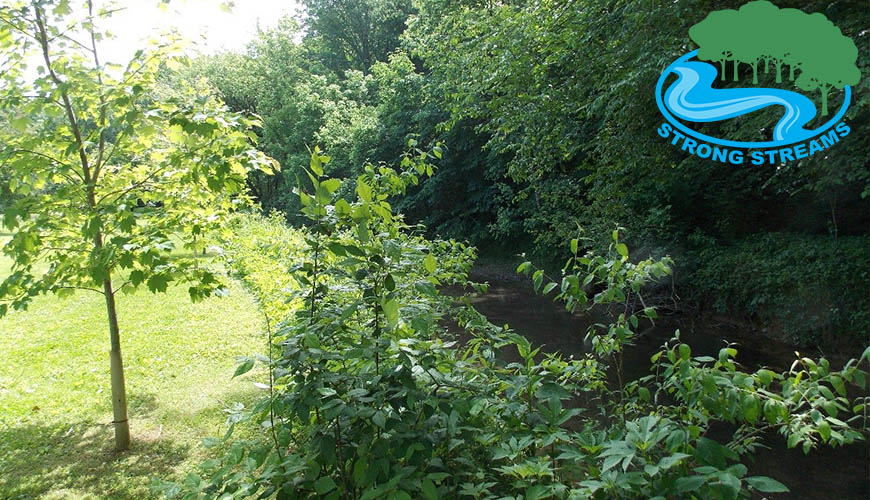Strong Streams – Buffers
What is a buffer?
A buffer (or riparian buffer) is an area of land adjacent to a waterway that contains a mix of trees, shrubs, grasses and wildflowers. This area of land “buffers” the waterway from upland impacts, including stormwater runoff and the pollutants that it carries. These pollutants come from a host of different land uses, and can include sediment from construction sites, nutrients like excess fertilizer and green waste, and toxins from chemicals, vehicle use and trash.
Why should I plant or maintain a buffer along the streambank in my yard?
Buffers are important for a number of reasons. If you’re a landowner with a stream running through or adjacent to your property, buffers can help to reduce streambank erosion and land loss, control flooding, and attract desirable wildlife.
Buffers also help communities! In parks, public places and floodplains, vegetation such as native trees, shrubs, forbs and grasses planted alongside a creek or stream help to soak up excess rain and stormwater flowing from upland, and control flooding and associated mosquito breeding grounds.
Fish, birds, deer, butterflies, hummingbirds, grassland birds, ducks and other desirable native wildlife thrive in buffer environments, as these habitats provide food and shelter for many aquatic and upland species. Buffers can also function as wildlife corridors when they are allowed to grow in long stretches.
We’ve grouped the benefits of buffers into three areas:
They can save landowners time and money
- You can reduce the amount of time and money you spend mowing your lawn by leaving 5’, 10’, 25’ or as much space as you can spare. The more space you leave, the more time you have to do other things.
- Mowing all the way up to the edge of the stream can encourage soil erosion, bank sloughing, and land loss. The roots of native species grow deep and hold the streambank in place, preventing this progressive stream bank failure. Repairing stream bank failure is often costly and time-consuming.
- Native trees, shrubs and grasses soak up rain and stormwater, reducing flooding and preventing mosquito breeding grounds.
They are beautiful, particularly when native species are abundant
- When managed to control invasive species and allow native species to thrive, buffers can take on the appearance of a natural meadow, grassland, or managed forest.
- Invasive plants are aggressive and can turn a scenic viewshed into an unkempt eyesore. Keeping privet, bush honeysuckle, mimosa trees and other common invasive species at bay in the initial years of buffer establishment will allow native wildflowers and desirable species to outcompete undesirable species in subsequent growing seasons.
They can help the environment
- Native vegetation provides shade to the creek, which cools the water and keeps oxygen levels at optimum concentrations for aquatic species.
- Buffers provide habitat for wildlife. Wood ducks use cavities or nest boxes along larger streams for nesting. Trees like the river birch are hosts for butterflies like the tiger swallowtail. Monarchs lay their eggs exclusively on swamp milkweed. Deer, birds and other wildlife use evergreen shrubs and trees as winter cover.
- Native forbs, grasses and trees offer an abundant food source throughout the year for upland and aquatic species. Birds use over-hanging branches along the water to forage for fish. Native shrubs and small trees like American holly, inkberry, persimmon and gray dogwood provide fruit for many wildlife species throughout the year. Larger trees like red oak supply acorns for mammals and waterfowl during the fall.
Download the Urban Riparian Buffer Handbook
Help us spread the word about buffers!
Below are marketing materials that are free to the public or other municipality.

Click here for a downloadable version of the “Tougher Buffer” print ad

Click here for a downloadable version of the “Buffer Benefits & Incentives” brochure.



